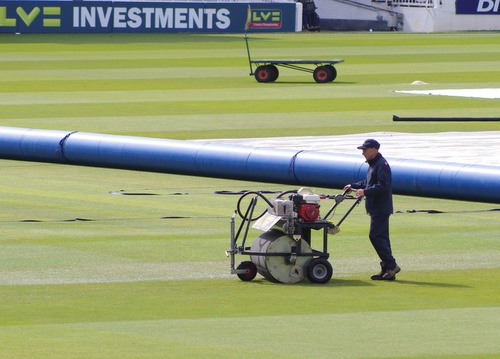The first week of the International Wine Challenge has ended. A great week, and the new venue, Lord’s, has been great.
OK, the lunches aren’t quite as good as the Michelin-star level creations of Searcy’s at the Barbican, but they’re still well above par – two courses, plenty of variety. The Barbican was logistically ideal, but the advantage the Nursery Pavillion has is natural light.

The strength of the competition is the quality of the judges. The odd nutter or bad taster might slip through the net, but because of the extensive feedback they are quickly weeded out. I’ve had only nice, competent people judging with me this week, and this makes the whole process – which is inevitably tough work with around 13 000 wines to get through – much more fun.
The weather has been pretty horrible, though. Cold and wet and wintry. The Middlesex game that was supposed to be taking place on Thursday and Friday was almost completely washed out, although a few overs were possible on Friday between the heavy rain showers.

One change this year has been the presence of two scientists from the Australian Wine Research Institute who are helping Sam Harrop out with the faults clinic. They are Geoff Cowey and Martin Day. As well as lending their expertise to the diagnosis of faults, they are taking samples of suspected faulty wines back to Australia for chemical analysis.

Since the faults clinic was established by Sam in 2006, over 90 000 wines have passed through the competition, which is a remarkable sample. Of these, 6.4% have been deemed faulty by sensory analysis. This year there will be a chance to see how this sensory analysis correlates with chemical analysis, something that wine science geeks like me are very excited about.

Sam says that 60% of wines sent to him as faulty are declared not faulty: he takes a conservative approach. In terms of figures, cork taint has been 2.7% over the 6 years it has been logged, and brett has been 1.6% (but this is confined to red wines, so it is more of a problem than this figure indicates). The three chief faults, representing a quarter of all faults each, have been cork taint, oxidation and reduction/sulfur compounds (sulfides and mercaptans).
3 Comments on Day 5 of the IWC, and some comments on faults





I don’t think that those of us in the trade know enough about faults. If a wine is not right we need to be able to tell customers what it is (simply) that is wrong with it. I think we get TCA, Oxidation, Brett and probably most sulphurous / reduction issues – BUT lots of other things arise and telling someone – yes it isn’t right – but I don’t know what is wrong with it doesn’t carry much weight.
I don’t think we need to go down a route beyond sensory analysis locally – but there has to be room in wine education for fault exploration. I’d love to see WSET including something on faults, certainly in Diploma but also in Advanced – surely it’s important. That said I’m not sure their tutors would be up to it (all of them anyway – some are exceptionally good) for reasons I think I’ve told you in the past. BUT if we’re going to tell people how to sell wine, how to recognise and analyse the quality of wine surely helping them to understand when a wine is faulty not poor quality is really important. And being able to tell a customer what that fault is too.
I’d be very interested to see the results of this faulty wine analysis. Raises a lot of questions. Any TCA, as far as I know, is bad but who sets the threshold on things like VA in big reds or sweet wines and how much of the Brett produced compounds, such as 4-EP and 4-EG, do you need before it’s a fault, rather than complexing? Are pyraziney Cabs ok and what levels of which sweaty mercaptans are ok in Sauv Blancs? Could they measure “the amount of oak” in a wine and divide it by how “thin” or “full-bodied” it is?
No doubt some sort of matrix would be needed for different wines styles, taking into account parameters such as age, alcohol, RS, tannins etc before you could come up with ranges of key analysable parameters where people might start to regard wines as faulty. And no doubt the AWRI will do an excellent job.
I love pyraziney Cabs, and I’m ok with some Brett character in European reds……….is it ok to love faults?
My FULL ON complaint about these wine tasting shows… is that the good wines quite rightly are praised, however, the awful and shoddy wines that should be avoided at all costs are discarded from printed comment – one NEVER sees comments like ‘awful oxidised reptile tank’ or similar.
my point is that its great to read positive comments, but the negative are equally valid to the consumer.